How to Train Clients With Obesity (Free Guide)
Learning to train clients with obesity can significantly broaden your clientele as a personal trainer. However, it’s crucial that you possess the right tools and knowledge to effectively learn how to train obese clients. The use of certain features in personal training software can be of great assistance in this task. Discover how to train overweight clients and all the best online personal training tools you’ll need in this comprehensive guide.
- Training clients with obesity requires an empathetic approach that incorporates gradual increases in physical activity, dietary changes, and motivation to make long-term lifestyle modifications.
- Most clients with obesity will benefit from low-impact workouts that reduce strain on joints, along with nutritional guidance to help create a calorie deficit without compromising nutritional needs.
- Incorporating workout and assessment software can help in tracking progress, scheduling appropriate workouts, and managing dietary needs, ensuring your clients reach their weight management goals safely and effectively.
Guiding clients with obesity towards their weight management goals can offer personal trainers a rewarding way to significantly impact their clients’ fitness journeys and overall health.
To train clients with obesity effectively, it’s important to not only understand the complexities of obesity but also to have the right tools to monitor progress, adapt training plans, and manage dietary needs; this is where personal training software becomes invaluable. By leveraging the features offered by the best online personal training software, you can guide clients with obesity in a way that boosts their health and fitness in a safe and sustainable manner.

Experience the leading personal training software from Exercise.com by booking a demo today!
Understanding Obesity: Causes, Effects, and Challenges
In today’s world, where obesity rates continue to rise, it is crucial for fitness professionals to be equipped with the knowledge and skills to effectively train clients with obesity. These individuals face unique challenges and require specialized approaches to help them achieve their fitness goals. In this comprehensive guide, we will dive deep into the various aspects of training clients with obesity, exploring the causes, effects, and challenges associated with obesity, as well as the importance of tailored training programs and strategies for long-term success.
Obesity is a complex health condition characterized by an excessive accumulation of body fat. Its causes are multifactorial, influenced by a combination of genetic, environmental, and behavioral factors. Sedentary lifestyles, unhealthy dietary habits, and genetic predispositions are among the primary contributors to this epidemic. Additionally, obesity can have severe physical and psychological effects, including a higher risk of chronic diseases, reduced mobility, low self-esteem, and depression.
Training clients with obesity requires a deep understanding of these causes, effects, and challenges. It is important to approach these individuals with empathy, respect, and sensitivity to create a safe and welcoming environment that encourages open communication and fosters trust.
Furthermore, it is crucial to recognize that obesity is not solely a result of personal choices or lack of willpower. Socioeconomic factors, such as limited access to affordable healthy food options and safe recreational spaces, can also contribute to the development and persistence of obesity. Addressing these structural barriers is essential in promoting long-term success in managing and preventing obesity.
The Importance of Tailored Training Programs for Clients With Obesity
When it comes to training clients with obesity, a one-size-fits-all approach simply won’t suffice. Each individual comes with their own unique needs, goals, and limitations. Therefore, it is crucial to develop tailored training programs that address these specific requirements while taking into consideration their current fitness levels, medical history, and any existing physical limitations.
A well-designed training program for clients with obesity should focus on gradual progress and emphasize a balanced combination of cardiovascular exercises, strength training, low-impact activities, and proper nutrition. This holistic approach ensures overall health improvements, weight management, and enhanced quality of life.
Furthermore, it is important to consider the psychological and emotional aspects of training clients with obesity. Many individuals with obesity may have experienced negative self-image, low self-esteem, and a history of unsuccessful weight loss attempts. Therefore, a tailored training program should also include strategies to address these psychological factors, such as promoting body positivity, providing emotional support, and setting realistic goals.
Read More: How to Help Clients Training for Weight Loss
Assessing the Unique Needs and Goals of Clients With Obesity
Before embarking on any training program, it is essential to assess the unique needs and goals of clients with obesity. Conducting comprehensive assessments, such as body composition analysis, cardiovascular fitness tests, and mobility assessments, provides valuable insights into their current physical condition and helps determine the most appropriate starting point.
Moreover, taking the time to understand their personal goals, preferences, and motivations enhances the effectiveness of the training program. It allows for personalized goal setting, which plays a pivotal role in maintaining motivation and adherence throughout their fitness journey.
Additionally, it is important to consider the psychological and emotional aspects of clients with obesity. Many individuals with obesity may have experienced stigma, discrimination, or negative self-image, which can impact their motivation and self-esteem. By creating a supportive and non-judgmental environment, trainers can help clients build confidence and develop a positive mindset towards their fitness goals.
Building Trust and Rapport with Clients With Obesity
Building trust and rapport is the foundation of any successful trainer-client relationship. This aspect becomes even more critical when working with clients with obesity, as they may have experienced judgment or stigma in the past. As a fitness professional, it is essential to create a welcoming, judgment-free, and supportive environment.
Establishing trust involves active listening, empathy, and demonstrating a genuine understanding of their unique challenges. By acknowledging their individual experiences and offering guidance without judgment, clients will feel empowered and motivated to make positive changes in their lives.
Another important aspect of building trust and rapport with clients with obesity is to educate yourself about the specific needs and considerations of this population. Understanding the physiological and psychological factors that contribute to obesity can help you tailor your approach and provide more effective support.
In addition, it is crucial to set realistic goals and expectations with clients with obesity. Many individuals with obesity have likely tried various weight loss methods in the past, and may have experienced disappointment or frustration. By setting achievable goals and celebrating small victories along the way, you can help clients build confidence and maintain motivation.
Setting Realistic and Achievable Fitness Goals for Clients With Obesity
Setting realistic and achievable fitness goals is crucial when working with clients with obesity. It is important to shift the focus from the number on the scale to overall health improvements. Encourage clients to prioritize their well-being by setting performance-based goals, such as completing a 5K run, improving their flexibility, or increasing their strength and endurance.
By emphasizing non-scale victories and celebrating the progress made beyond weight loss, clients are more likely to stay motivated and committed to their fitness journey. Remember, sustainable progress takes time, and small victories along the way are worth celebrating.
Another important aspect of setting fitness goals for clients with obesity is to consider their individual abilities and limitations. It is crucial to tailor the goals to their specific needs and abilities, taking into account any physical limitations or medical conditions they may have. This personalized approach ensures that the goals are realistic and achievable for each client, increasing their chances of success.
In addition to setting performance-based goals, it is also important to focus on behavior changes and building healthy habits. Encourage clients to make sustainable lifestyle changes, such as incorporating regular physical activity into their daily routine, adopting a balanced and nutritious diet, and practicing stress management techniques. By focusing on these long-term changes, clients can achieve not only their fitness goals but also improve their overall health and well-being.
Incorporating Cardiovascular Exercises for Weight Loss and Improved Health
Cardiovascular exercises play a vital role in weight loss and overall health improvement. They help burn calories, increase cardiovascular fitness, and contribute to maintaining a healthy body weight. When designing a training program for clients with obesity, it is important to include a variety of cardiovascular exercises that are enjoyable, attainable, and safe.
Options such as walking, cycling, swimming, or using low-impact cardio machines can be excellent choices. Gradually increasing the duration and intensity of these exercises helps clients build stamina and increase their calorie-burning potential.
Additionally, incorporating interval training into cardiovascular workouts can be highly beneficial. Interval training involves alternating between high-intensity bursts of exercise and periods of rest or lower intensity. This type of training has been shown to increase calorie burn, improve cardiovascular endurance, and enhance overall fitness levels.
Furthermore, it is important to consider the individual’s preferences and limitations when selecting cardiovascular exercises. Some individuals may find group fitness classes or team sports more enjoyable and motivating, while others may prefer solo activities such as running or using cardio equipment at home. By tailoring the exercise program to the individual’s interests and abilities, adherence and long-term success can be greatly improved.
Strength Training Strategies to Support Weight Loss and Increase Muscle Mass in Clients With Obesity
Contrary to common misconceptions, strength training is an essential component of any training program for clients with obesity. Incorporating strength training exercises helps increase lean muscle mass, boost metabolism, and support long-term weight loss.
When developing strength training strategies, it is crucial to prioritize proper form and technique, gradually increase resistance, and provide modifications when necessary. Encouraging compound movements that engage multiple muscle groups, such as squats, lunges, and chest presses, can yield significant benefits.
In addition to the physical benefits, strength training also plays a crucial role in improving overall health and reducing the risk of chronic diseases. Regular strength training can help lower blood pressure, improve insulin sensitivity, and enhance cardiovascular health.
Furthermore, incorporating strength training into a weight loss program can help prevent muscle loss that often occurs during calorie restriction. By preserving muscle mass, individuals can maintain a higher metabolic rate, making it easier to sustain weight loss in the long term.
Implementing Low-Impact Exercises to Minimize Joint Stress for Clients With Obesity
For clients with obesity, joint stress can be a significant concern. To mitigate this risk, incorporating low-impact exercises is essential. These exercises minimize stress on the joints while still allowing clients to improve their cardiovascular fitness and burn calories.
Low-impact exercises, such as swimming, water aerobics, elliptical training, or using stationary bikes, are excellent options to consider. These activities provide a challenging workout without putting excessive strain on the joints, reducing the risk of injuries and ensuring long-term adherence to the training program.
Nutrition Education and Guidance for Clients with Obesity: Key Considerations
When training clients with obesity, nutrition education and guidance are crucial. It is essential to emphasize the importance of a balanced and sustainable approach to eating, rather than restrictive diets or quick fixes.
Aim to educate clients on proper portion control, the importance of macronutrients, and the value of making informed food choices. Encouraging mindful eating, promoting nutrient-dense foods, and providing practical tips for meal planning and preparation can empower clients to make long-lasting changes to their eating habits.
Addressing Emotional and Psychological Factors in Training Clients with Obesity
Emotional and psychological factors play a significant role in managing obesity. Many individuals with obesity may struggle with emotional eating, body image concerns, and low self-esteem. Therefore, addressing these aspects is crucial when working with clients with obesity.
Creating a safe space for discussion, actively listening, and providing support are essential elements of helping clients overcome emotional barriers. Ensuring a holistic approach that incorporates stress management techniques, promotes positive body image, and offers access to mental health resources can greatly enhance clients’ overall well-being.
Overcoming Plateaus and Staying Motivated in the Journey to Weight Loss
Weight loss journeys are often accompanied by plateaus, which can be demotivating for clients with obesity. Understanding that plateaus are a normal part of the process is crucial in helping clients stay focused and committed to their goals.
To overcome plateaus, it is important to introduce variety into their training program, modify exercise intensity or duration, and reassess nutrition strategies. Implementing progressive overload, incorporating new exercises, or trying different workout formats can help push through plateaus and reignite progress.
Celebrating Non-Scale Victories: Tracking Progress Beyond the Numbers on the Scale
When training clients with obesity, it is essential to shift the focus from scale readings. There are numerous non-scale victories that deserve recognition and celebration. Encourage clients to keep track of their improvements, such as increased energy levels, improved sleep quality, enhanced flexibility, or reduced reliance on medications.
By highlighting and celebrating these achievements, clients become more motivated, and their self-confidence grows. It reinforces the notion that fitness and health goals extend beyond weight loss alone.
The Role of Sleep and Stress Management in Supporting Weight Loss Efforts for Clients With Obesity
Sleep and stress management are often overlooked but critical aspects when it comes to weight loss and overall health improvement for clients with obesity. Poor sleep quality and chronic stress can negatively impact hormone regulation, metabolism, and food cravings.
Encouraging clients to prioritize sleep hygiene, adopt relaxation techniques like meditation or yoga, and implement stress management strategies can hugely benefit their weight loss journey. Quality sleep and effective stress management contribute to improved overall well-being and support long-term success.
Strategies for Long-Term Success: Maintaining Weight Loss and Preventing Relapse
Maintaining weight loss and preventing relapse can be challenging for clients with obesity. However, with the right strategies and ongoing support, it is achievable. Emphasize the importance of adopting sustainable lifestyle changes rather than short-term fixes.
Key strategies include creating an environment conducive to healthy habits, fostering a support network, setting new goals, and regularly reassessing progress. By providing ongoing guidance, accountability, and motivation, trainers can significantly contribute to their clients’ long-term success and help them maintain their weight loss achievements.
Training clients with obesity requires specific approaches and considerations. By understanding the causes, effects, and challenges associated with obesity, implementing tailored training programs, addressing emotional and psychological factors, and promoting long-term sustainable changes, fitness professionals can make a significant impact on their clients’ lives. Empathy, sensitivity, and a holistic approach are keys to creating a safe, supportive, and inclusive training environment that empowers clients with obesity to achieve their fitness goals, improve their overall health, and promote long-lasting well-being.
What type of training is recommended for people with obesity?
For individuals with obesity, a combination of cardiovascular exercise, strength training, and flexibility exercises is recommended. Cardiovascular exercises like walking, cycling, swimming, or using an elliptical machine can help improve cardiovascular health, burn calories, and aid in weight loss. Strength training, using bodyweight exercises or resistance training equipment, helps build muscle mass, increase metabolism, and improve body composition. Flexibility exercises, such as stretching or yoga, enhance range of motion and overall mobility. It’s important to start at a comfortable intensity and progress gradually, working with a qualified fitness professional to design a safe and effective training program.
What other diet and lifestyle recommendations are appropriate for obese clients?
In addition to exercise, adopting a healthy diet and lifestyle is crucial for managing obesity. Encourage a balanced, nutrient-dense diet that includes plenty of fruits, vegetables, whole grains, lean proteins, and healthy fats. Emphasize portion control and mindful eating to prevent overeating. Encourage regular meal timings, adequate hydration, and minimizing processed and sugary foods. Promote consistent physical activity throughout the day, such as walking or taking the stairs, and encourage reducing sedentary behavior. Prioritize sufficient sleep, stress management, and establishing a support system for motivation and accountability.
How do you help someone who is struggling with obesity?
Supporting someone who is struggling with obesity requires a compassionate and personalized approach. Establish a trusting and non-judgmental relationship, focusing on their overall well-being rather than just weight loss. Encourage self-reflection to identify underlying emotional and behavioral factors that contribute to their struggles with weight. Help them set realistic goals and create a comprehensive plan that includes healthy eating, regular physical activity, stress management, and behavior modification techniques. Provide ongoing support, motivation, and accountability, and connect them with a registered dietitian, therapist, or support groups specialized in obesity management when necessary.
What should exercise programs for people who are obese do?
Exercise programs for people who are obese should prioritize safety, gradual progression, and a focus on building strength, cardiovascular fitness, and flexibility. Start with low-impact activities like walking, swimming, or cycling, gradually increasing duration and intensity over time. Incorporate strength training exercises that target major muscle groups, using resistance machines, free weights, or bodyweight exercises. Ensure proper form, provide modifications as needed, and encourage rest and recovery days. Individualize the program to accommodate any physical limitations and progress at a pace that is both challenging and sustainable. Regular monitoring, goal setting, and positive reinforcement are essential for long-term success.
What is the best activity for an obese person?
The best activity for an obese person is one that they enjoy and can sustain over time. This could include walking, swimming, cycling, low-impact aerobics, or using cardio machines like the elliptical or stationary bike. These activities are gentle on the joints and can be easily modified to suit an individual’s fitness level. It’s important to choose an activity that is enjoyable, as it increases the likelihood of adherence and long-term commitment to regular exercise.
What are some strategies you could use with an obese client?
When working with an obese client, it’s important to implement strategies that promote a positive mindset and healthy behaviors. Encourage setting realistic and achievable goals, focusing on progress rather than perfection. Implement behavior modification techniques such as self-monitoring, goal-setting, and problem-solving. Provide education on nutrition, portion control, and mindful eating. Support the development of a support network, whether it’s through family, friends, or joining a community or group fitness program. Regularly celebrate achievements and milestones, providing positive reinforcement and motivation along the journey.
What is the 5 A approach to obesity?
The 5 A approach to obesity management involves the following steps:
- Assess: Conduct a comprehensive assessment of the client’s health, including medical history, physical fitness, and lifestyle factors.
- Advise: Provide clear and evidence-based advice on the importance of weight management, healthy eating, regular physical activity, and behavior modification.
- Agree: Collaborate with the client to establish realistic and achievable goals, considering their preferences, readiness for change, and individual circumstances.
- Assist: Offer support, resources, and tools to help the client implement healthy lifestyle changes. This may include meal planning, exercise programs, counseling, or referrals to other healthcare professionals.
- Arrange: Provide ongoing follow-up, monitoring, and follow-through to ensure the client’s progress, address any barriers, and make necessary adjustments to their plan.
How do you motivate someone to lose weight?
Motivating someone to lose weight involves understanding their individual motivations and tailoring the approach accordingly. It’s important to focus on intrinsic motivations, such as improving health, enhancing quality of life, and increasing self-confidence, rather than external factors like societal pressures or appearance. Help the person set specific, realistic, and achievable goals, and break them down into smaller milestones for a sense of accomplishment along the way. Offer ongoing support, encouragement, and celebrate their successes. Incorporate positive reinforcement, such as rewards or praise, when they make progress. Utilize behavior change techniques, such as self-monitoring, goal-setting, and problem-solving, to empower them and build self-efficacy.
How can you advise an obese person on healthy living goals?
When advising an obese person on healthy living goals, it’s important to take a holistic approach that considers their physical, mental, and emotional well-being. Encourage them to set realistic and specific goals related to nutrition, physical activity, stress management, and self-care. Provide education on healthy eating habits, portion control, and balanced nutrition. Emphasize the importance of regular physical activity, suggesting activities they enjoy and can incorporate into their daily routine. Encourage them to seek support from healthcare professionals, registered dietitians, and therapists as needed. Empower them to make gradual, sustainable changes and focus on long-term lifestyle improvements rather than short-term fixes.
How do you tell someone they need to lose weight?
Approaching the topic of weight loss with sensitivity and empathy is crucial. It’s important to focus on health rather than appearance and to emphasize the positive benefits of weight management. Choose a private and comfortable setting for the conversation. Start by expressing concern for their well-being and frame the discussion around improving overall health and quality of life. Use “I” statements to convey your observations and feelings rather than sounding judgmental. Offer support and understanding, and assure them that you’re there to help and provide resources. Be prepared to listen actively and respond with empathy, as their journey towards weight management may involve complex emotional factors. Encourage them to seek guidance from healthcare professionals, such as registered dietitians or doctors, who can provide expert advice tailored to their specific needs.
Should obese people do cardio or weights?
Both cardio and weight training have their benefits for individuals who are obese. Cardio exercises, such as brisk walking, swimming, cycling, or using cardio machines, can help burn calories, improve cardiovascular health, and aid in weight loss. It’s important to start slowly and gradually increase the intensity and duration of cardio exercises as fitness levels improve.
Weight training, on the other hand, helps build lean muscle mass, which can increase metabolism and support long-term weight management. It also improves strength, mobility, and overall body composition. Incorporating resistance exercises with weights or bodyweight can help preserve existing muscle mass and promote fat loss.
A well-rounded fitness routine for someone who is obese should ideally include a combination of cardiovascular exercises and strength training. It’s important to tailor the exercise program to individual abilities, preferences, and any existing health conditions. Consulting with a fitness professional or healthcare provider can help create a safe and effective exercise plan that takes into account individual needs and goals.
Can obese people do strength training?
Yes, strength training can be beneficial for individuals who are obese. In fact, it can play a crucial role in their weight management and overall health. Strength training helps build muscle mass, which not only increases strength but also boosts metabolism. This means that individuals who engage in strength training can burn more calories even at rest, which can aid in weight loss and weight maintenance.
Strength training also offers several other benefits for obese individuals. It improves body composition by reducing body fat and increasing lean muscle mass. It enhances bone density, joint stability, and overall functional capacity, which can improve daily activities and quality of life. Additionally, strength training can positively impact insulin sensitivity, blood pressure, and cholesterol levels, helping to manage obesity-related health conditions.
When starting a strength training program, it’s important to begin with proper form and technique. Gradually progress the intensity, resistance, and complexity of the exercises as strength and fitness levels improve. Working with a qualified fitness professional, such as a personal trainer, can ensure that the exercises are performed correctly and safely.
Remember that each individual is unique, and it’s important to tailor the strength training program to individual abilities, preferences, and any existing health conditions. Consulting with a healthcare provider or fitness professional can help develop a safe and effective strength training routine that meets the specific needs and goals of someone who is obese.
Use the Best Personal Training Software to Offer a Stellar Client Experience
Training clients who are overweight requires a comprehensive and tailored approach. See how Exercise.com can help.

To learn more about how Exercise.com can help you run your fitness business, book a demo now!
Creating Training Plans for Clients Who are Obese
Here’s how you can help your clients accomplish their goals by using workout plan creator software to create workout plans, run fitness challenges, offer online workout groups, message clients, and more, all from your very own custom branded fitness apps.
Exercise.com stands out as an all-in-one fitness business management software with comprehensive workout plan sales capabilities. The robust member management, billing & invoicing, and unique fitness assessment tools offer a one-stop solution for fitness business needs. Here’s just some of what you can do with the Exercise.com platform:
Engage with clients via automations.
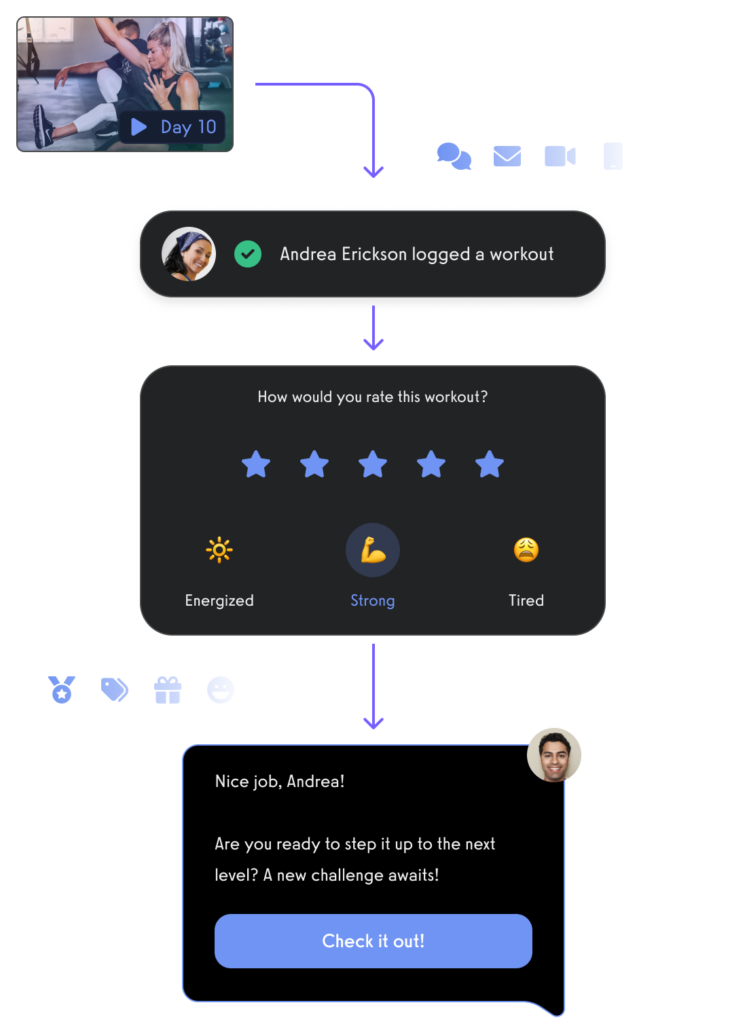
Manage leads with a fitness CRM. Read More: Best Gym CRM Software
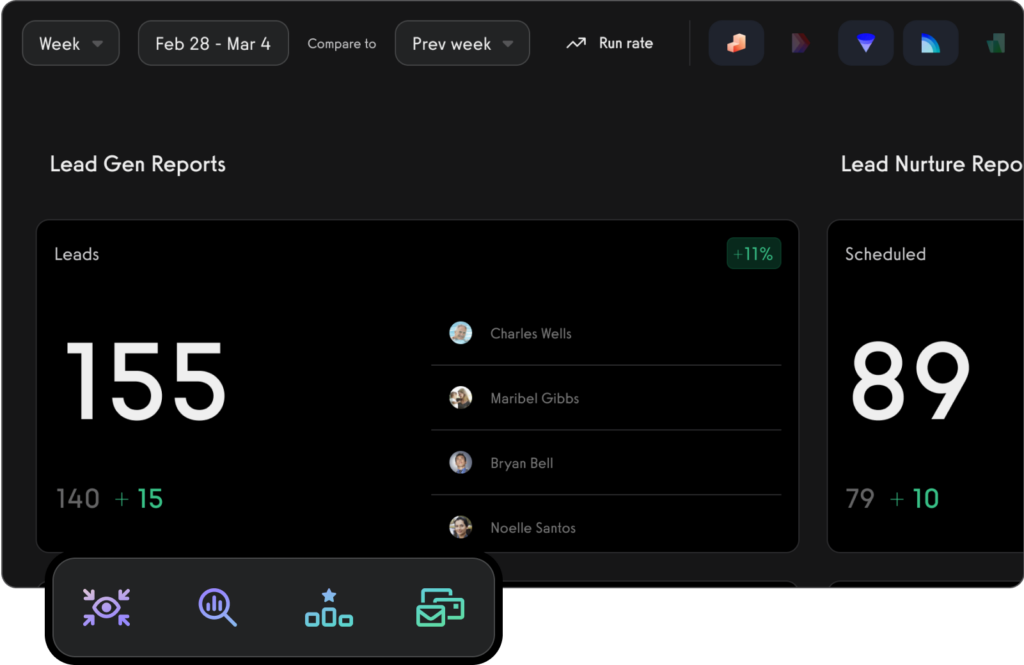
Create and send fitness assessments with ease.
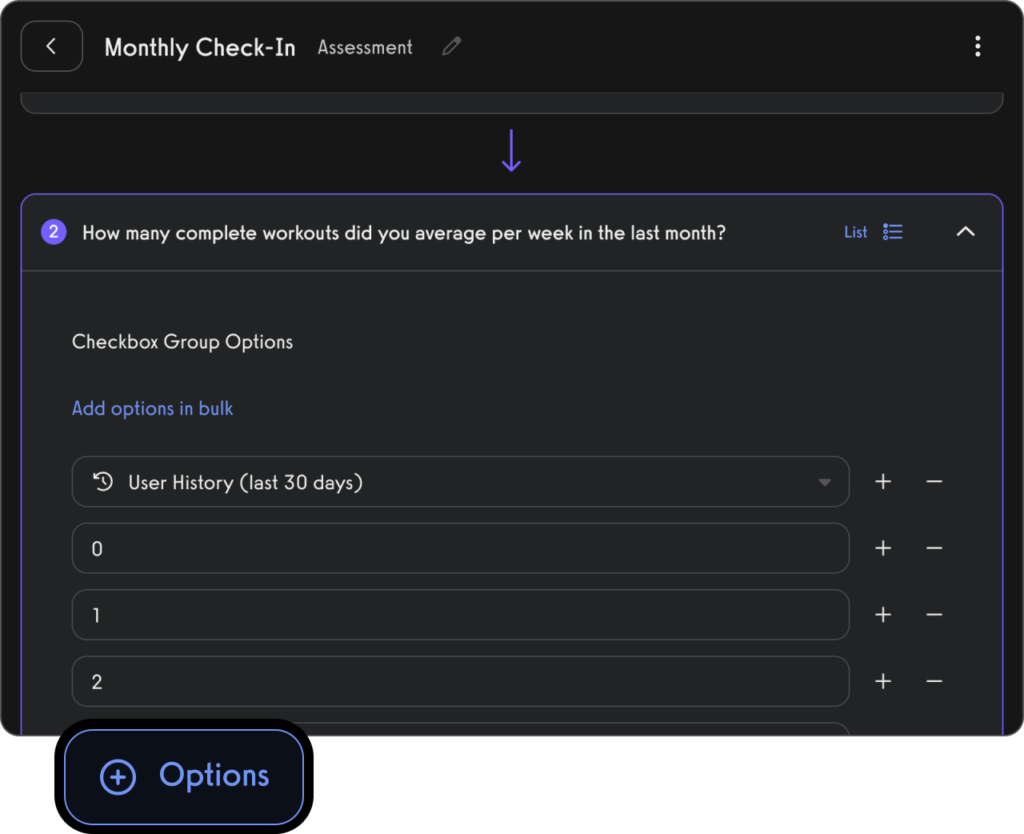
Use fitness habit tracking to inspire and motivate personal training clients (in-person and remote).

Use fitness progress photos to engage with clients.
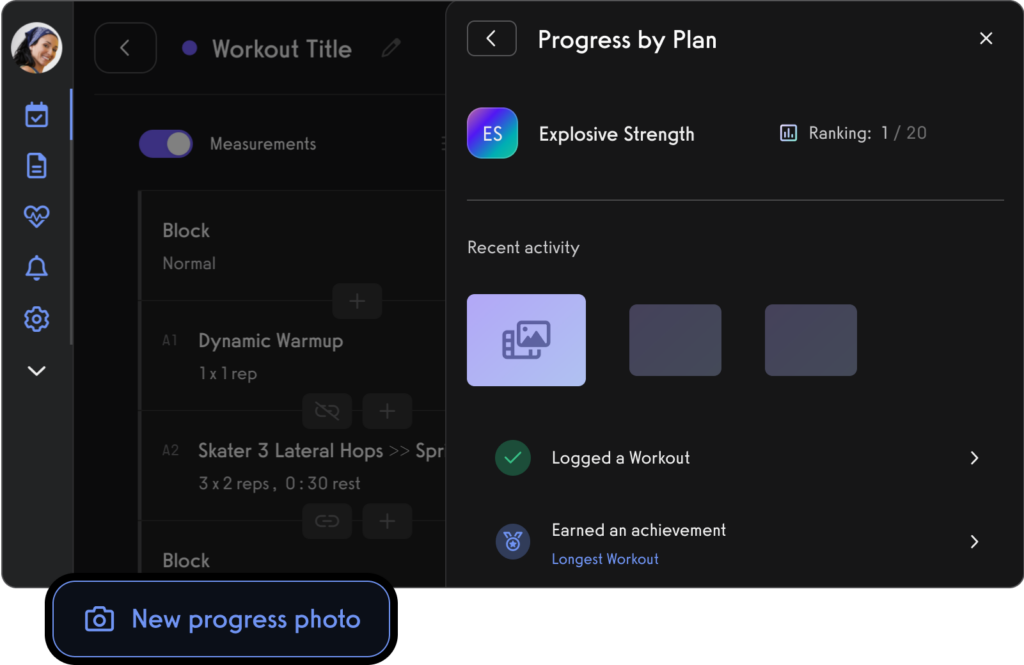
Use fitness leaderboards to track performance and inspire healthy competition.
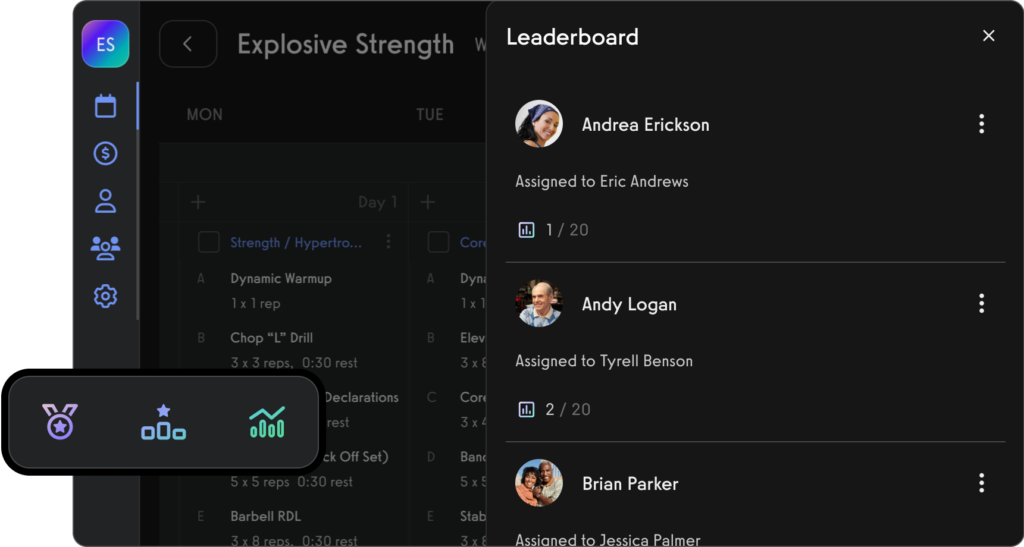
Use the exercise demonstration video library or create your own custom exercise demonstration videos.

Create workout plans for parents and dependents, teams and more.

Manage personal training clients with ease.

Book appointments for clients (Read More: Best Gym Booking Software)

Create classes and fitness groups

Manage fitness challenges (Read More: 100+ Fitness Challenge Ideas)
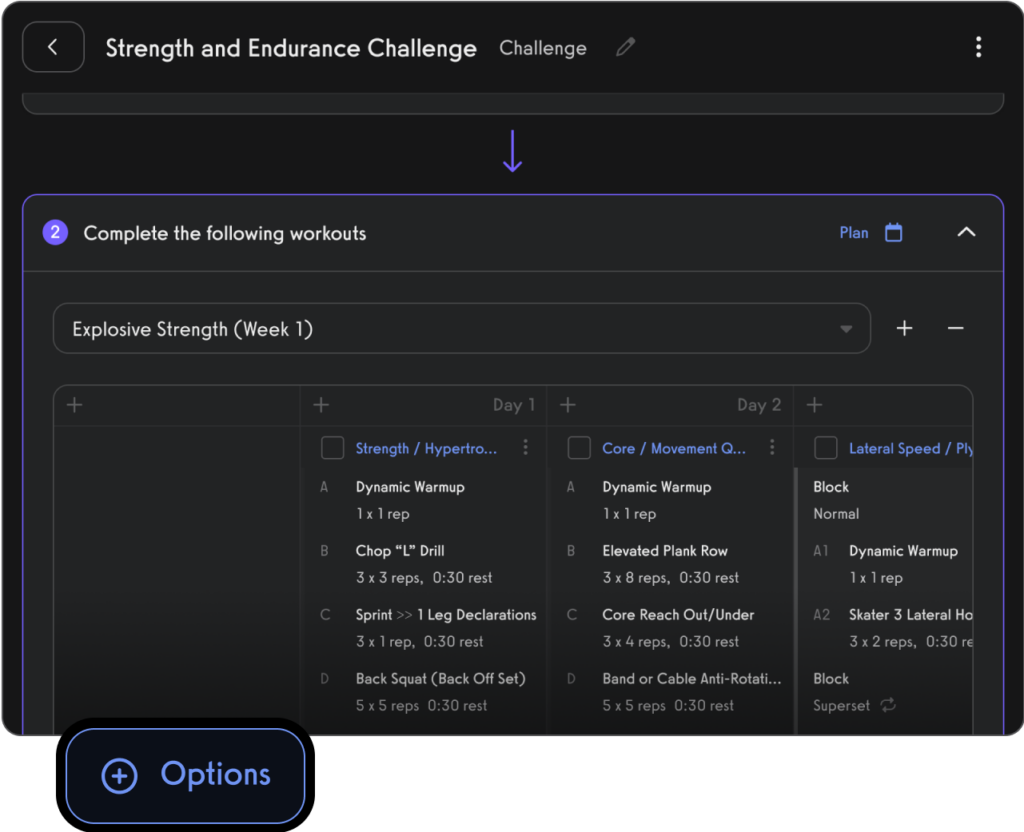
Process payments for open gym, classes, and personal training.

Communicate with gym members, athletes, team members, personal training clients, class members, parents, and dependents via SMS, email, and in-app push notification.
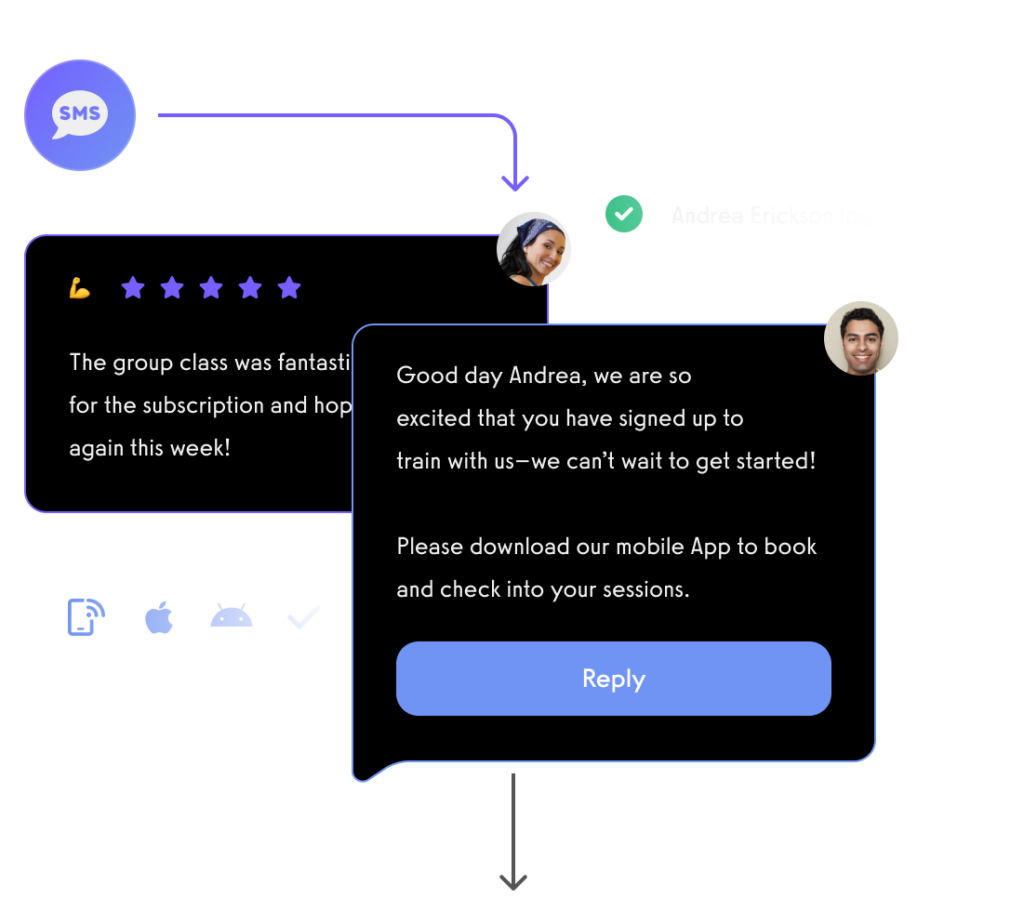
View performance over time, track personal records, and other fitness stats with performance reporting dashboards.
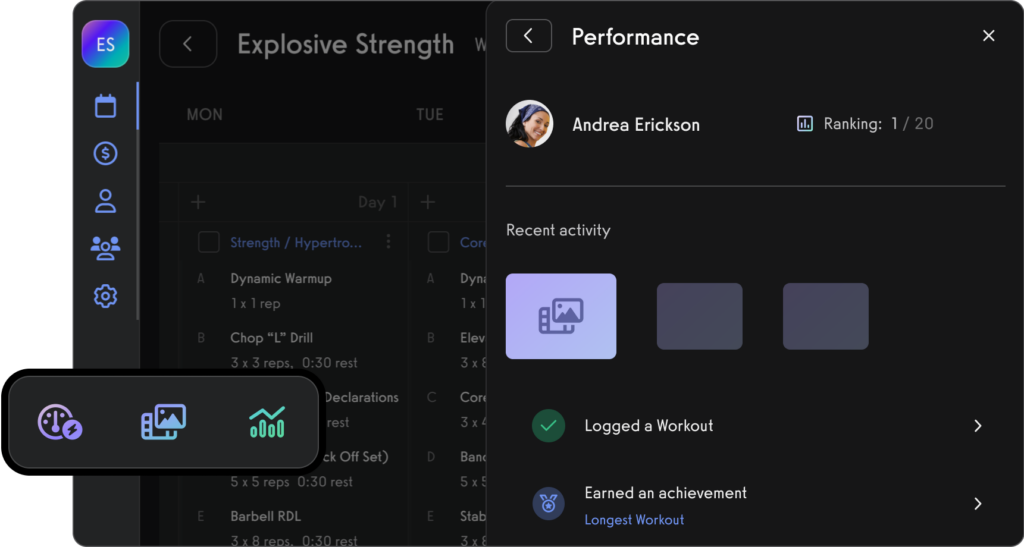
And of course, view all of your fitness business reports easily too.

All from your custom-branded fitness apps (Read More: Best Gym Mobile Fitness Apps Software)


Want to learn how your fitness business can take it to the next level? Get a demo now!









